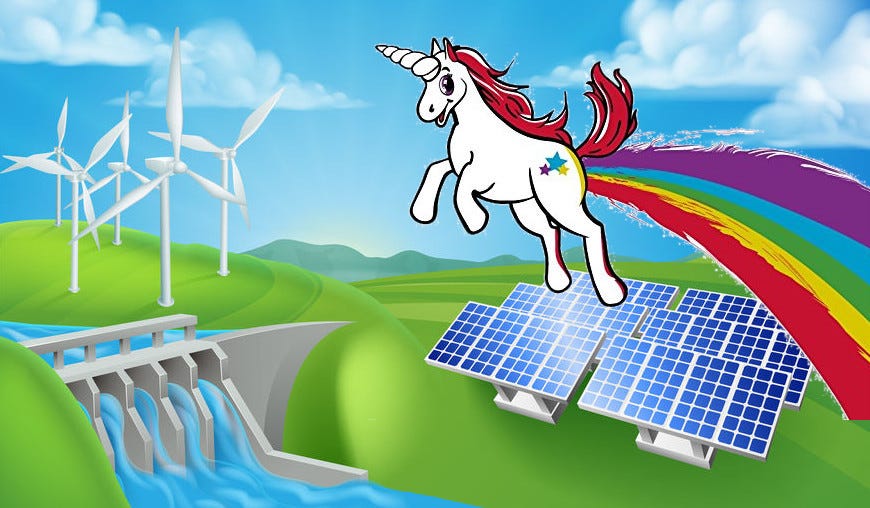Extraordinary Costs Of Green Energy Creeping Slowly Into Public Awareness
A key claim of the green energy movement has long been that the intermittent “renewables” — wind and solar — provide the cheapest form of energy. Therefore, the advocates say, just build enough wind turbines and solar panels, convert all use of energy to electricity, and sit back and enjoy a future of affordable energy without adverse environmental consequences.
Meanwhile a key theme at this blog has been exposing the incompetence and chicanery of the claims of low cost for electricity from wind and sun. Although it may often seem as if nobody is listening, I reassure myself that when the full costs of wind and solar electricity eventually get exposed, the people will catch on and not allow themselves to be impoverished.
Over in Europe, it looks like enough of the costs have now gotten exposed to cause the beginning of a public awakening. In
August I had a post on how the costs of “green” energy were starting to change the “net zero” debate in the UK. Now, add to that report the results of the elections this past weekend in Germany and Luxembourg. In both countries, parties now standing at least somewhat against the green transition scored gains, while Greens lost ground. The process of ultimate political transformation looks to be long and slow; but I have faith that reality will eventually win out.
First, a short refresher on the claims of green energy advocates that the wind and sun provide the cheapest power. If you only read this blog, or other climate skeptic sources, you may find it incredible that anyone could believe such assertions. But you must remember that the self-designated climate advocates repeat these claims to themselves endlessly in an echo chamber where no one ever pushes back. Eventually, it appears, they come to believe that the claims are true.
And thus, here is my
blog post from August 16, 2022, reporting on a Soho Forum debate on the energy future, between Steven Koonin and Andrew Dessler. Dessler, arguing for a future of wind and solar power, had as his main contention that those are cheaper than the fossil fuel alternatives, and therefore they will inevitably sweep the fossil fuel infrastructure away. Although he is some kind of leader in the climate alarm movement, Dessler appeared to have no clue that there was any counter-information to his contentions about the costs of wind and solar power. In support of his position, Dessler used as his main metric the “Levelized Cost of Energy” (LCOE) as published by investment bank Lazard. The LCOE metric is ridiculously flawed, and should not fool anybody, but seems to have fooled not just Dessler but also the entire green energy movement (and for that matter the entire Democratic Party and the President of the United States).
And nothing about LCOE and fraudulent advocacy based on it is going away. Long after the Soho Forum debate last August, Lazard went right ahead and came out with a new and updated Report in April titled
“2023 Levelized Cost of Energy+.” Here is the key chart from that Report:

You can see right there that the cost (measured by LCOE) of solar PV is $24-96/MWh, onshore wind is even less at $24-75/MWh, and the cheapest fossil fuel alternative is combined cycle natural gas at $39-101/MWh. So wind and solar are cheaper — QED! But, as I wrote in my August 16, 2022 post:
[A]n LCOE calculation completely omits the dominant costs of generating reliable electricity using mostly or entirely wind and solar generators. These dominant costs are the costs of energy storage and/or backup, the costs of overbuilding, and the costs of additional transmission.
Meanwhile over in Europe, I doubt that many people are abandoning the green movement based on complex spreadsheet calculations of the costs involved. Rather, most of them are starting to face up to reality because of some combination of skyrocketing electricity bills and plans to ban gas heat and internal combustion cars.
The
BBC reports here on the results of yesterday’s regional elections in the German states of Bavaria and Hesse. The swings in voter preferences were not huge, but still enough to be meaningful on the climate issue. For example, in Bavaria the BBC reports that the long-dominant CSU got 36.7% of the vote, and a second conservative party, the Free Voters (
Freie Währen) expanded to 15%, while the Greens
“slipped slightly” to 15% and the SPD (party of Chancellor Olaf Scholz) got only a
“catastrophic” 8%. The BBC has this to say about the issues in the Bavarian election:
In an unusually ferocious campaign in Bavaria, conservatives and right-wingers railed against Berlin’s plans to phase out fossil fuel boilers and high levels of migration.
While this was not a one-issue referendum on green energy, still it is clear from the results that opposing green energy in at least some respects was definitely a positive rather than a negative among the electorate.
In Luxembourg, the swings were also mostly small, but included a gain for the conservatives matched with a dramatic loss for the Greens.
Bloomberg reports on October 8 that the long-time ruling coalition of Democrats, Socialists and Greens got
“toppled.” In a parliament of 60, the Conservatives upped their total to 21 seats, while the Greens went from 9 seats to just 4. The result is likely to be a governing coalition of the conservatives with other parties, but excluding the Greens, which could mean a significant shift in green energy policies.
Back here in the U.S., the Biden administration continues with its wrecking ball approach to destroying our energy economy. But as Europe is showing us, small changes voter preferences can change that quickly after the next election.











